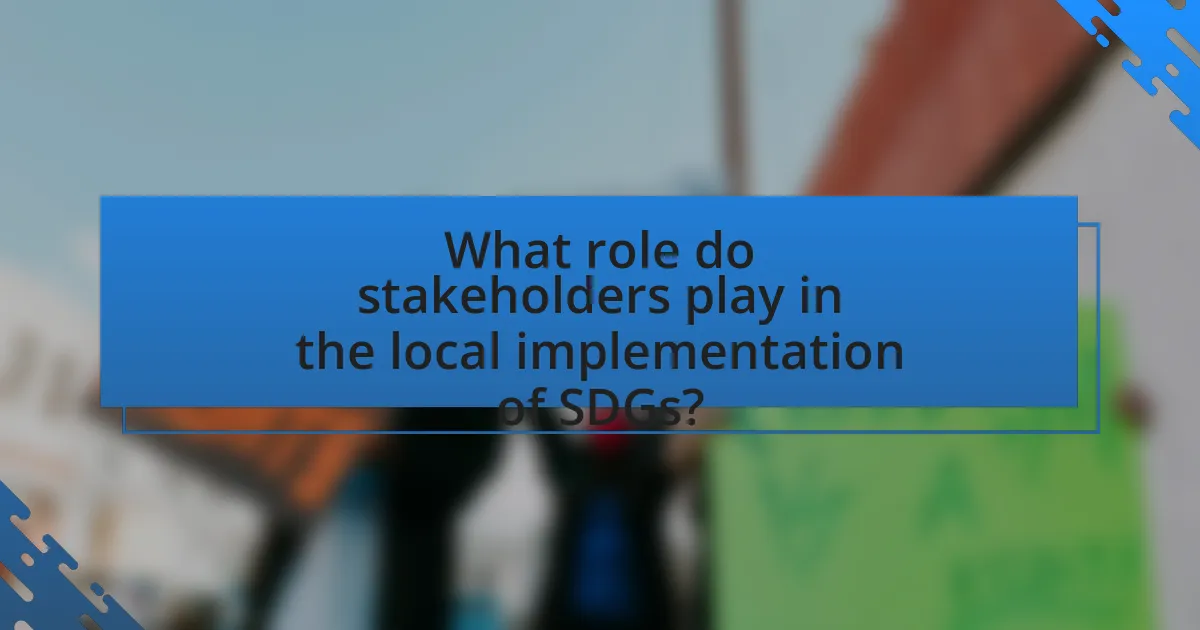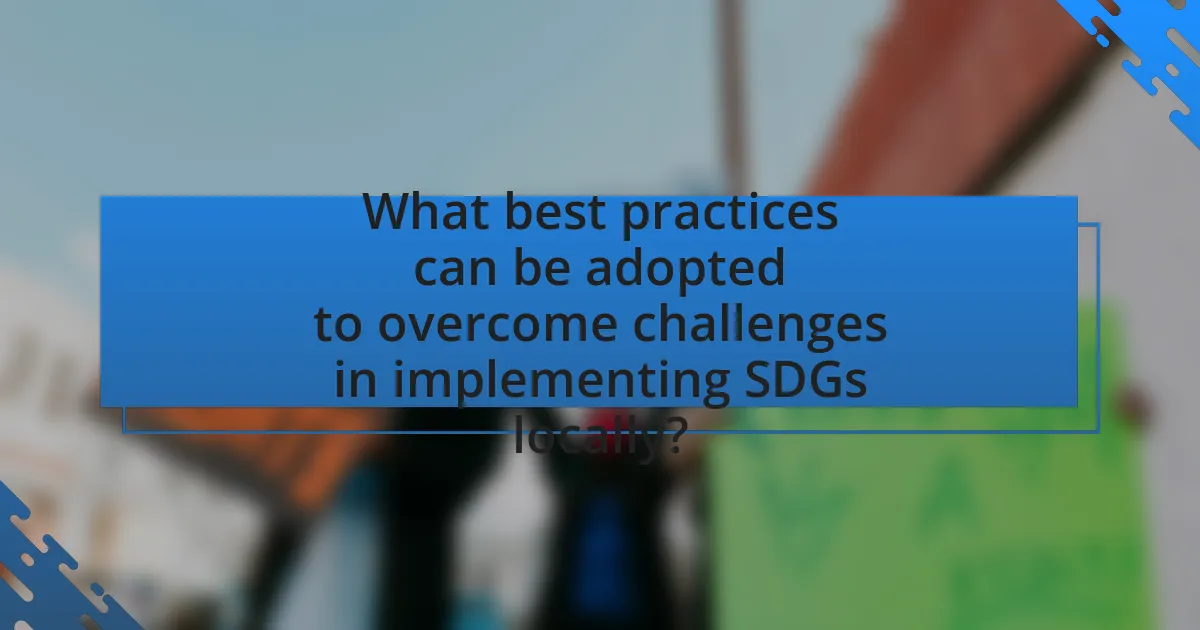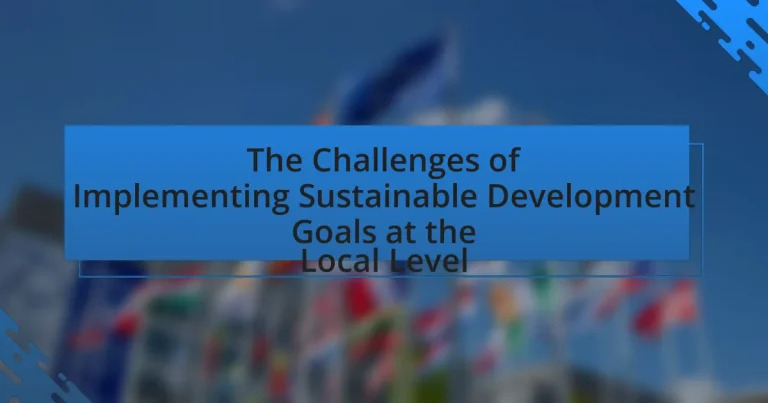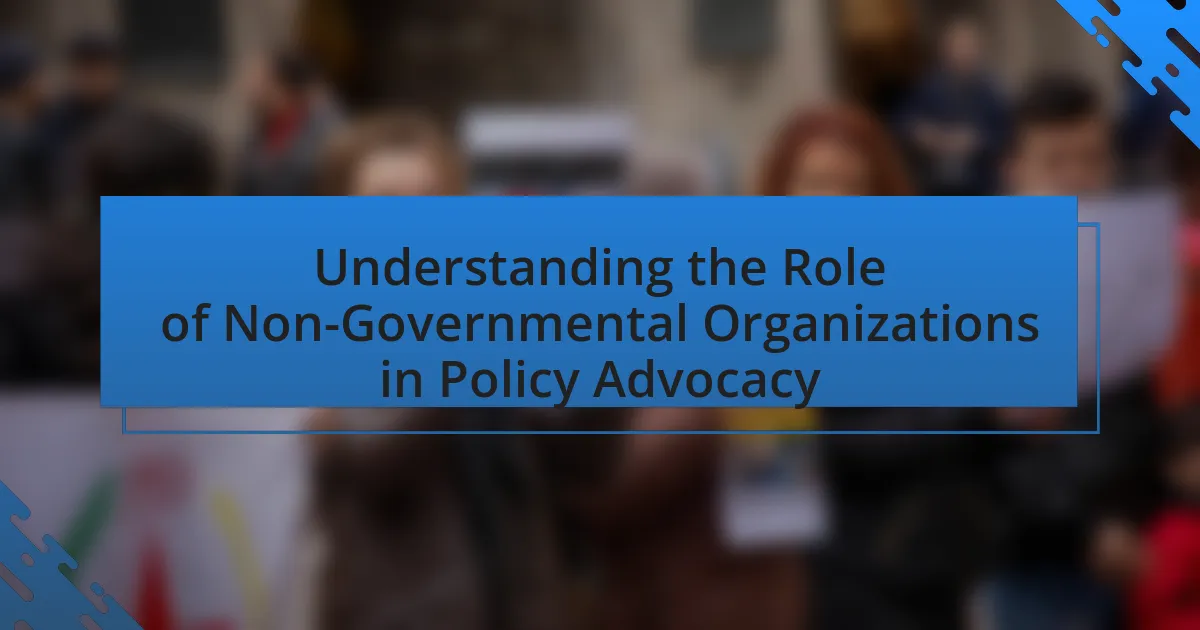The article examines the challenges of implementing Sustainable Development Goals (SDGs) at the local level, highlighting their significance in guiding communities towards sustainable development and improved quality of life. It discusses how local governance can align policies with key SDGs, such as poverty alleviation and sustainable urban development, while addressing financial constraints, lack of awareness, and the importance of stakeholder engagement. The article also explores best practices for resource allocation, innovative funding mechanisms, and the role of local leadership in driving SDG initiatives, providing case studies that exemplify successful local strategies.
-and-their-significance-at-the-local-level-1.webp)
What are the Sustainable Development Goals (SDGs) and their significance at the local level?
The Sustainable Development Goals (SDGs) are a set of 17 global objectives established by the United Nations in 2015 to address pressing social, economic, and environmental challenges by 2030. At the local level, the significance of the SDGs lies in their ability to guide communities in creating tailored strategies that promote sustainable development, enhance quality of life, and foster inclusive growth. For instance, local governments can align their policies with SDGs such as Goal 11, which focuses on making cities inclusive, safe, resilient, and sustainable, thereby addressing urban challenges directly relevant to their populations. This localized approach not only empowers communities to take ownership of their development but also facilitates the measurement of progress through specific indicators, ensuring accountability and transparency in achieving the global agenda.
How do the SDGs influence local governance and community development?
The Sustainable Development Goals (SDGs) influence local governance and community development by providing a framework for policy alignment and resource allocation that addresses local needs. Local governments utilize the SDGs to prioritize initiatives that promote social equity, economic growth, and environmental sustainability, thereby enhancing community resilience. For instance, the SDG 11 focuses on sustainable cities and communities, prompting local authorities to implement urban planning strategies that improve infrastructure and public services. This alignment is supported by evidence from various municipalities that have successfully integrated SDGs into their local development plans, resulting in improved quality of life and increased community engagement.
What are the key SDGs that impact local communities directly?
The key Sustainable Development Goals (SDGs) that impact local communities directly are SDG 1 (No Poverty), SDG 2 (Zero Hunger), SDG 3 (Good Health and Well-Being), SDG 4 (Quality Education), and SDG 11 (Sustainable Cities and Communities). These goals address fundamental needs such as poverty alleviation, food security, health care access, educational opportunities, and sustainable urban development, which are crucial for enhancing the quality of life in local communities. For instance, according to the United Nations, achieving SDG 1 can lift millions out of poverty, directly improving local economic conditions and community resilience.
How can local governments align their policies with the SDGs?
Local governments can align their policies with the Sustainable Development Goals (SDGs) by integrating these goals into local planning and decision-making processes. This involves conducting assessments to identify local priorities that correspond with the SDGs, engaging stakeholders in the development of policies, and ensuring that resource allocation reflects these priorities. For instance, cities like Barcelona have adopted local action plans that explicitly reference the SDGs, demonstrating a commitment to sustainable urban development. Additionally, local governments can utilize data and indicators to monitor progress towards the SDGs, ensuring accountability and transparency in their efforts.
What challenges do local governments face in implementing the SDGs?
Local governments face significant challenges in implementing the Sustainable Development Goals (SDGs), primarily due to limited financial resources. Many local authorities struggle with budget constraints that hinder their ability to allocate sufficient funds for SDG-related projects, as evidenced by a 2020 report from the United Nations Development Programme, which highlighted that over 70% of local governments worldwide lack the necessary financial capacity to meet the SDGs. Additionally, local governments often encounter difficulties in coordinating with various stakeholders, including national governments and civil society, which can lead to fragmented efforts and inefficiencies. Furthermore, a lack of technical expertise and data can impede effective planning and monitoring of SDG initiatives, as noted in the 2019 Global Sustainable Development Report, which emphasized the importance of data-driven decision-making for successful implementation.
What are the financial constraints affecting local SDG initiatives?
Local Sustainable Development Goal (SDG) initiatives face significant financial constraints primarily due to limited funding sources, inadequate budget allocations, and reliance on external grants. Many local governments struggle to secure sufficient financial resources, as they often operate under tight budgets that prioritize immediate needs over long-term sustainability projects. According to a report by the United Nations, local authorities frequently lack the financial capacity to implement comprehensive SDG strategies, with over 70% of municipalities reporting insufficient funds to meet their sustainability objectives. Additionally, the unpredictability of external funding, such as international aid or philanthropic contributions, further complicates financial planning for these initiatives.
How does lack of awareness hinder SDG implementation at the local level?
Lack of awareness significantly hinders Sustainable Development Goals (SDG) implementation at the local level by preventing communities from understanding the importance and relevance of these goals. When local populations are unaware of SDGs, they are less likely to engage in initiatives that promote sustainability, leading to insufficient local action and support. For instance, a study by the United Nations Development Programme (UNDP) found that communities with higher awareness levels of SDGs demonstrated greater participation in sustainability projects, highlighting the correlation between awareness and effective implementation. Without awareness, local stakeholders may also lack the necessary knowledge to align their policies and practices with SDG objectives, further impeding progress toward achieving these global goals.

What role do stakeholders play in the local implementation of SDGs?
Stakeholders play a crucial role in the local implementation of Sustainable Development Goals (SDGs) by facilitating collaboration, resource mobilization, and community engagement. Local governments, businesses, non-profit organizations, and community groups work together to align their efforts with the SDGs, ensuring that local priorities are addressed. For instance, a study by the United Nations Development Programme highlights that stakeholder involvement enhances accountability and transparency, leading to more effective local governance and sustainable outcomes. Additionally, stakeholders contribute local knowledge and expertise, which is essential for tailoring SDG initiatives to specific community needs, thereby increasing the likelihood of successful implementation.
How can community engagement enhance the effectiveness of SDG initiatives?
Community engagement enhances the effectiveness of Sustainable Development Goal (SDG) initiatives by fostering local ownership and ensuring that the initiatives are tailored to the specific needs of the community. When communities actively participate in the planning and implementation of SDG initiatives, they are more likely to support and sustain these efforts, leading to better outcomes. For example, research by the United Nations Development Programme (UNDP) indicates that community-driven projects often achieve higher success rates because they incorporate local knowledge and priorities, resulting in solutions that are culturally relevant and widely accepted. This alignment with community values increases participation and resource mobilization, ultimately driving the success of SDG initiatives.
What strategies can be employed to involve local citizens in SDG planning?
To involve local citizens in Sustainable Development Goals (SDG) planning, strategies such as participatory budgeting, community workshops, and stakeholder consultations can be employed. Participatory budgeting allows citizens to directly influence how public funds are allocated, fostering ownership and accountability. Community workshops facilitate dialogue between local governments and residents, enabling the sharing of ideas and concerns regarding SDG implementation. Stakeholder consultations ensure that diverse voices, including marginalized groups, are heard, promoting inclusivity in the planning process. These strategies have been shown to enhance civic engagement and improve the relevance of SDG initiatives to local contexts, as evidenced by case studies from cities like Porto Alegre in Brazil, where participatory budgeting has led to increased public satisfaction and better resource allocation.
How do partnerships with NGOs and private sectors contribute to local SDG efforts?
Partnerships with NGOs and private sectors enhance local Sustainable Development Goal (SDG) efforts by leveraging resources, expertise, and networks to address specific community needs. These collaborations often result in innovative solutions, as NGOs bring grassroots knowledge and community engagement, while private sectors contribute funding and technological advancements. For instance, a study by the United Nations Development Programme (UNDP) highlights that partnerships can increase the effectiveness of local initiatives by 30% through shared resources and coordinated actions. This synergy not only accelerates project implementation but also fosters sustainable practices that align with SDG targets, demonstrating the critical role of collaborative efforts in achieving local development objectives.
What are the implications of political will on local SDG implementation?
Political will significantly influences local Sustainable Development Goal (SDG) implementation by determining the prioritization of resources and policy frameworks. When local governments exhibit strong political will, they are more likely to allocate funding, engage stakeholders, and create supportive policies that facilitate the achievement of SDGs. For instance, a study by the United Nations Development Programme (UNDP) highlights that regions with committed political leadership often see higher rates of SDG progress, as seen in countries like Costa Rica, where government initiatives have led to substantial advancements in environmental sustainability and social equity. Conversely, a lack of political will can result in inadequate resource allocation and ineffective policies, hindering local efforts to meet SDG targets.
How does political stability affect the progress of SDG projects?
Political stability significantly enhances the progress of Sustainable Development Goal (SDG) projects by creating an environment conducive to effective governance and resource allocation. When a country experiences political stability, it typically leads to consistent policy implementation, increased investor confidence, and better coordination among stakeholders, all of which are crucial for the successful execution of SDG initiatives. For instance, according to the United Nations Development Programme, nations with stable political environments are more likely to achieve their SDG targets, as they can maintain long-term strategies and mobilize necessary funding without the disruptions caused by political unrest or changes in leadership.
What role does local leadership play in driving SDG initiatives?
Local leadership is crucial in driving Sustainable Development Goal (SDG) initiatives as it fosters community engagement, mobilizes resources, and ensures that local needs are addressed. Effective local leaders can align SDG objectives with community priorities, facilitating tailored solutions that resonate with residents. For instance, a study by the United Nations Development Programme highlights that local governments play a pivotal role in implementing SDGs by integrating them into local development plans, thereby enhancing accountability and transparency. This localized approach not only empowers communities but also accelerates progress towards achieving the SDGs by leveraging local knowledge and networks.

What best practices can be adopted to overcome challenges in implementing SDGs locally?
To overcome challenges in implementing Sustainable Development Goals (SDGs) locally, stakeholders should adopt a multi-stakeholder approach that fosters collaboration among government, civil society, and the private sector. This approach enhances resource mobilization and ensures diverse perspectives are included in decision-making processes. For instance, the United Nations Development Programme (UNDP) emphasizes the importance of localizing SDGs through participatory governance, which has been shown to increase community ownership and accountability in various case studies. Additionally, integrating SDGs into local development plans and policies ensures alignment with national priorities, facilitating smoother implementation. Evidence from cities like Bristol in the UK demonstrates that aligning local strategies with SDGs can lead to improved social equity and environmental sustainability.
How can local governments effectively allocate resources for SDG projects?
Local governments can effectively allocate resources for Sustainable Development Goal (SDG) projects by conducting comprehensive needs assessments and prioritizing projects based on community impact and alignment with SDG targets. This approach ensures that resources are directed towards initiatives that address the most pressing local issues, such as poverty reduction or environmental sustainability.
For instance, a study by the United Nations Development Programme (UNDP) highlights that local governments that engage in participatory budgeting processes are more successful in aligning their resource allocation with community needs, resulting in improved project outcomes. By leveraging data analytics and community feedback, local governments can make informed decisions that maximize the effectiveness of their resource allocation for SDG projects.
What innovative funding mechanisms can support local SDG initiatives?
Innovative funding mechanisms that can support local Sustainable Development Goal (SDG) initiatives include social impact bonds, crowdfunding platforms, and blended finance models. Social impact bonds enable private investors to fund social programs with returns based on the achievement of specific outcomes, thus aligning financial incentives with social objectives. Crowdfunding platforms allow communities to raise funds directly from individuals who support local projects, fostering grassroots engagement and investment. Blended finance models combine public and private funding to leverage additional resources for local initiatives, effectively increasing the capital available for sustainable development projects. These mechanisms have been shown to mobilize significant resources; for instance, the Global Impact Investing Network reported that impact investments reached $715 billion in 2020, demonstrating the potential for innovative funding to drive local SDG efforts.
How can data-driven decision-making improve local SDG outcomes?
Data-driven decision-making can significantly improve local Sustainable Development Goal (SDG) outcomes by enabling precise identification of community needs and resource allocation. By analyzing data on local demographics, economic conditions, and environmental factors, decision-makers can tailor interventions that directly address specific challenges faced by their communities. For instance, a study by the United Nations Development Programme (UNDP) highlighted that cities utilizing data analytics to track progress on SDGs saw a 30% increase in effective resource distribution, leading to enhanced service delivery in areas such as health and education. This targeted approach not only optimizes the use of available resources but also fosters accountability and transparency, ultimately driving better local SDG outcomes.
What lessons can be learned from successful local SDG implementations?
Successful local SDG implementations demonstrate the importance of community engagement and tailored strategies. Engaging local stakeholders ensures that initiatives reflect the specific needs and priorities of the community, leading to higher participation rates and more effective outcomes. For instance, the city of Freiburg in Germany successfully integrated sustainability into urban planning by involving residents in decision-making processes, resulting in a 40% reduction in CO2 emissions since 1992. Additionally, successful implementations highlight the necessity of strong partnerships across sectors, as seen in the collaboration between local governments, NGOs, and businesses in the city of Medellín, Colombia, which improved public transport and reduced inequality. These examples illustrate that local adaptations and collaborative efforts are crucial for achieving the Sustainable Development Goals effectively.
What case studies exemplify effective local SDG strategies?
Case studies that exemplify effective local Sustainable Development Goal (SDG) strategies include the city of Freiburg in Germany, which has implemented comprehensive sustainable urban planning and renewable energy initiatives, resulting in a significant reduction in carbon emissions and increased public transport usage. Another example is the municipality of Medellín in Colombia, where innovative public transport solutions and social urbanism have transformed the city, improving access to services and reducing inequality. These case studies demonstrate successful local governance and community engagement in achieving SDGs, supported by measurable outcomes such as Freiburg’s 40% reduction in greenhouse gas emissions by 2030 and Medellín’s recognition as a model for urban innovation.
How can these lessons be replicated in other local contexts?
Lessons from implementing Sustainable Development Goals (SDGs) can be replicated in other local contexts by adapting strategies to fit specific cultural, economic, and environmental conditions. For instance, successful community engagement practices used in one locality can be modified to resonate with the values and needs of another community, ensuring local stakeholders are actively involved in the decision-making process. Evidence from various case studies, such as the “Localizing the SDGs” report by the United Nations Development Programme, highlights that tailoring initiatives to local contexts increases ownership and effectiveness, demonstrating that localized approaches lead to better outcomes in achieving SDGs.
What practical steps can local governments take to enhance SDG implementation?
Local governments can enhance Sustainable Development Goal (SDG) implementation by integrating SDGs into local policies and planning processes. This involves conducting assessments to identify local priorities aligned with the SDGs, engaging stakeholders through public consultations, and establishing clear metrics for monitoring progress. For instance, the United Nations Development Programme (UNDP) emphasizes the importance of localizing the SDGs to ensure that they reflect community needs and aspirations. Additionally, local governments can allocate budgets specifically for SDG-related initiatives, fostering partnerships with civil society and the private sector to leverage resources and expertise. By adopting these practical steps, local governments can create a more effective framework for achieving the SDGs at the local level.





